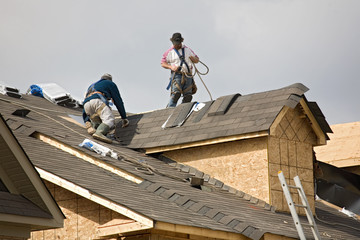A sturdy, well-maintained roof is essential for protecting homes and businesses from weather, structural damage, and energy loss. Whether installing a new roof or repairing an existing one, professional roofing contractors provide the expertise, tools, and materials needed to ensure long-lasting results. Hiring the right contractor guarantees safety, quality workmanship, and peace of mind for any roofing project.

The Importance of Hiring Roofing Contractors
Roofing may appear simple, but it involves technical skills, safety measures, and specialized equipment. Professional roofing contractors have the experience to handle various materials, slopes, and roof types. They ensure proper installation, repair, and maintenance, which prevents costly issues such as leaks, water damage, or structural problems.
Additionally, roofing contractors are knowledgeable about building codes, warranties, and safety regulations. They provide solutions tailored to a property’s unique needs, ensuring durability, energy efficiency, and aesthetic appeal.
Services Offered by Roofing Contractors
Professional roofing contractors offer a wide range of services to meet the demands of both residential and commercial properties:
- Roof Installation – Installing new roofs with precision using high-quality materials.
- Roof Repair – Fixing leaks, damaged shingles, cracks, or storm damage to prevent further issues.
- Roof Replacement – Removing old roofs and installing durable, modern roofing systems.
- Roof Inspection – Evaluating the condition of roofs to identify damage or potential problems.
- Maintenance Programs – Regular inspections, cleaning, and minor repairs to extend the life of roofs.
- Emergency Roofing Services – Rapid response for unexpected damage caused by storms or accidents.
These comprehensive services ensure that all aspects of roof care are addressed by skilled professionals.
Benefits of Hiring Professional Roofing Contractors
Hiring experienced roofing contractors offers several advantages:
- Quality Workmanship – Professional techniques ensure roofs are installed or repaired correctly for long-lasting durability.
- Time Efficiency – Skilled teams complete projects faster without compromising quality.
- Safety – Proper equipment, training, and safety measures reduce the risk of accidents.
- Expert Recommendations – Contractors guide clients on material selection, roofing systems, and maintenance schedules.
- Cost Savings – Preventive care and correct installation reduce the need for frequent repairs.
These benefits make professional roofing services a valuable investment for protecting property and ensuring peace of mind.
Tips for Choosing Roofing Contractors
Selecting the right contractor is essential for a successful roofing project. Consider these tips:
- Verify Credentials – Check licenses, insurance, and certifications to ensure legitimacy and protection.
- Ask for References – Review past projects and client testimonials to assess experience and quality.
- Obtain Multiple Quotes – Compare costs, materials, and timelines from different contractors.
- Discuss Materials – Confirm the types of roofing materials and their durability.
- Clarify Scope of Work – Ensure inspection, installation, cleanup, and finishing tasks are included.
- Check Warranties – Ask about workmanship and material warranties for added protection.
Following these guidelines helps property owners avoid costly mistakes and ensures a smooth project.
Preparing for a Roofing Project
Proper preparation improves efficiency and results. Consider these steps:
- Clear the Area – Remove outdoor furniture, vehicles, and valuables from the vicinity.
- Communicate Goals – Clearly explain preferences for materials, colors, and styles.
- Plan for Weather – Schedule projects during favorable conditions to avoid delays.
- Ensure Access – Contractors need easy access to the roof for equipment and materials.
- Budget Appropriately – Allocate funds for materials, labor, and potential contingencies.
By preparing properly, clients enable roofing contractors to work efficiently and deliver the best results.
Common Roofing Challenges
Even with professional contractors, roofing projects may encounter challenges:
- Weather Conditions – Rain, snow, and extreme temperatures can delay work.
- Structural Issues – Roof frames may require reinforcement or repair before installation.
- Material Delays – Availability of shingles, tiles, or metal panels can affect timelines.
- Complex Roof Designs – Unique slopes, angles, or architectural features require careful planning.
Experienced roofing contractors anticipate these challenges and implement solutions to maintain high-quality outcomes.
Types of Roofing Materials
Professional contractors work with a variety of materials, each offering unique advantages:
- Asphalt Shingles – Affordable, durable, and available in various colors.
- Metal Roofing – Long-lasting, energy-efficient, and resistant to harsh weather.
- Tile Roofing – Offers a classic look, excellent durability, and fire resistance.
- Slate Roofing – Extremely durable with a sophisticated, natural appearance.
- Flat Roofing Systems – Common in commercial buildings, suitable for modern designs.
Contractors help select materials based on budget, climate, and desired aesthetics, ensuring a balance between performance and style.
Roof Maintenance Tips
Maintaining a roof extends its lifespan and prevents costly repairs:
- Regular Inspections – Check for leaks, cracks, and damaged shingles at least twice a year.
- Clean Gutters and Downspouts – Prevent water accumulation and damage to the roof and foundation.
- Trim Overhanging Branches – Reduce the risk of falling debris damaging the roof.
- Prompt Repairs – Address minor issues immediately to prevent more extensive damage.
- Protect Against Moss and Algae – Use safe treatments to maintain roof integrity and appearance.
Routine maintenance ensures roofs remain strong, functional, and visually appealing.
Roofing contractors provide essential expertise for protecting homes and businesses. From installation and repair to inspections and maintenance, professional contractors deliver high-quality results that safeguard properties from damage and extend the life of roofs.
By hiring skilled roofing contractors, property owners enjoy durable, energy-efficient, and visually appealing roofs while avoiding common pitfalls associated with DIY or inexperienced work. Proper preparation, material selection, and maintenance ensure long-lasting protection and value for years to come.
Whether upgrading an existing roof, repairing damage, or building a new structure, professional roofing services are a worthwhile investment for safety, comfort, and peace of mind.
